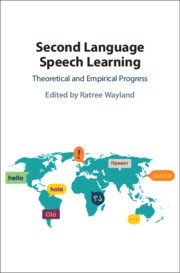Book contents
- Second Language Speech Learning
- Second Language Speech Learning
- Copyright page
- Dedication
- Contents
- Figures
- Tables
- Contributors
- Preface
- Acknowledgments
- Part I Theoretical Progress
- Part II Segmental Acquisition
- Chapter 6 English Obstruent Perception by Native Mandarin, Korean, and English Speakers
- Chapter 7 Changes in the First Year of Immersion
- Chapter 8 Effects of the Postvocalic Nasal on the Perception of American English Vowels by Native Speakers of American English and Japanese
- Part III Acquiring Suprasegmental Features
- Part IV Accentedness and Acoustic Features
- Part V Cognitive and Psychological Variables
- Index
- References
Chapter 6 - English Obstruent Perception by Native Mandarin, Korean, and English Speakers
from Part II - Segmental Acquisition
Published online by Cambridge University Press: 21 January 2021
- Second Language Speech Learning
- Second Language Speech Learning
- Copyright page
- Dedication
- Contents
- Figures
- Tables
- Contributors
- Preface
- Acknowledgments
- Part I Theoretical Progress
- Part II Segmental Acquisition
- Chapter 6 English Obstruent Perception by Native Mandarin, Korean, and English Speakers
- Chapter 7 Changes in the First Year of Immersion
- Chapter 8 Effects of the Postvocalic Nasal on the Perception of American English Vowels by Native Speakers of American English and Japanese
- Part III Acquiring Suprasegmental Features
- Part IV Accentedness and Acoustic Features
- Part V Cognitive and Psychological Variables
- Index
- References
Summary
This study investigates the perceptual accuracy of eight English obstruents in the onset and coda position by Mandarin and Korean-speaking L2 learners and by a control group of native English speakers. According to the current theoretical models on second language speech learning, L1 Mandarin and Korean speakers are expected to differ in their perception of English obstruents due to the different correspondence between their respective L1 obstruents and those in English. On the other hand, theories based on intrinsic differences in the difficulty of different linguistic skills imply that some L2 sounds would be more difficult than others regardless of the L1 background. The results showed that all three groups were significantly more accurate in perceiving obstruents in the onset than in the coda position, voiceless than voiced targets, stops than fricatives, and labials than coronals. /θ/ and /ð/ were particularly poorly identified. The two learner groups were equally accurate in the onset position, but the Mandarin group outperformed the Korean group in the coda position. Regarding the specific obstruents, some patterns were predicted by mapping to the L1. Nonetheless, the general similarity between the two groups suggests a robust and pervasive language-independent tendency in speech perception.
- Type
- Chapter
- Information
- Second Language Speech LearningTheoretical and Empirical Progress, pp. 195 - 212Publisher: Cambridge University PressPrint publication year: 2021



